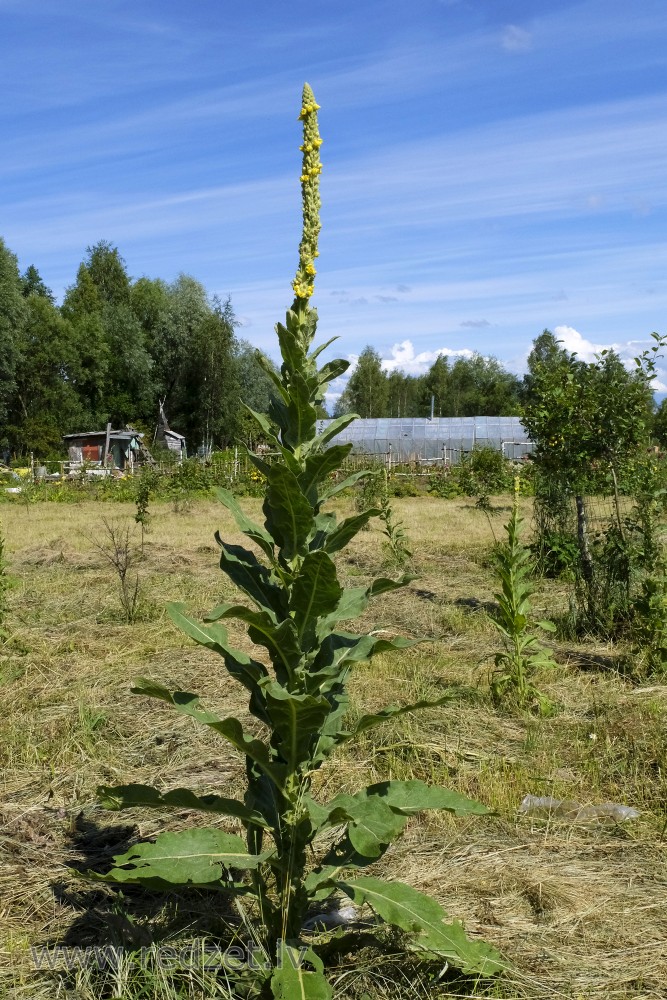(Verbascum thapsus) Great mullein
Verbascum thapsus, the great mullein or common mullein, is a species of mullein native to Europe, northern Africa, and Asia, and introduced in the Americas and Australia.
It is a hairy biennial plant that can grow to 2 m tall or more. Its small, yellow flowers are densely grouped on a tall stem, which grows from a large rosette of leaves. It grows in a wide variety of habitats, but prefers well-lit, disturbed soils, where it can appear soon after the ground receives light, from long-lived seeds that persist in the soil seed bank. It is a common weedy plant that spreads by prolifically producing seeds, and has become invasive in temperate world regions.It is a minor problem for most agricultural crops, since it is not a competitive species, being intolerant of shade from other plants and unable to survive tilling. It also hosts many insects, some of which can be harmful to other plants. Although individuals are easy to remove by hand, populations are difficult to eliminate permanently.
Although commonly used in traditional medicine, there are no approved drugs from this plant,and it has been used to make dyes and torches.
Description
V. thapsus is a dicotyledonous plant that produces a rosette of leaves in its first year of growth. The leaves are large, up to 50 cm long. The second-year plants normally produce a single unbranched stem, usually 1–2 m tall. In the eastern part of its range in China, it is, however, only reported to grow up to 1.5 m tall. The tall, pole-like stems end in a dense spike of flowers that can occupy up to half the stem length. All parts of the plants are covered with star-shaped trichomes. This cover is particularly thick on the leaves, giving them a silvery appearance. The species' chromosome number is 2n = 36.
On flowering plants, the leaves are alternately arranged up the stem. They are thick and decurrent, with much variation in leaf shape between the upper and lower leaves on the stem, ranging from oblong to oblanceolate, and reaching sizes up to 50 cm long and 14 cm across (19 inches long and 5 inches wide).They become smaller higher up the stem,and less strongly decurrent down the stem.The flowering stem is solid and 2–2.5 cm (nearly an inch) across, and occasionally branched just below the inflorescence,usually following damage. After flowering and seed release, the stem and fruits usually persist in winter,drying into dark brown, stiff structures of densely packed, ovoid-shaped, and dry seed capsules. The dried stems may persist into the following spring or even the next summer. The plant produces a shallow taproot.
Flowers are pentamerous with (usually) five stamen, a five-lobed calyx tube and a five-petalled corolla, the latter bright yellow and an 1.5–3 cm (0.59–1.18 in) wide. The flowers are almost sessile, with very short pedicels (2 mm, 0.08 in). The five stamens are of two types, with the three upper stamens being shorter, their filaments covered by yellow or whitish hairs, and having smaller anthers, while the lower two stamens have glabrous filaments and larger anthers.The plant produces small, ovoid (6 mm, 0.24 in) capsules that split open by way of two valves, each capsule containing large numbers of minute, brown seeds less than 1 mm (0.04 in)in size, marked with longitudinal ridges. A white-flowered form, V. thapsus f. candicans, is known to occur.Flowering lasts up to three months from early to late summer (June to August in northern Europe), with flowering starting at the bottom of the spike and progressing irregularly upward; each flower opens for part of a day and only a few open at the same time around the stem.
Uses
Phytochemicals
Phytochemicals in Verbascum thapsus flowers and leaves include saponins, polysaccharides, mucilage, flavonoids, tannins, iridoid and lignin glycosides, and essential oils.The plant's leaves, in addition to the seeds, have been reported to contain rotenone, although quantities are unknown.
Traditional medicine
Although long used in herbal medicine, no high-quality clinical research has been conducted on Verbascum thapsus as of 2018, and there are no drugs manufactured from its components. Dioscorides first recommended the plant 2000 years ago, believing it useful as a folk medicine for pulmonary diseases. Leaves were smoked to attempt to treat lung ailments, a tradition that in America was rapidly transmitted to Native American peoples. The Zuni people, however, use the plant in poultices of powdered root applied to sores, rashes and skin infections. An infusion of the root is also used to treat athlete's foot. All preparations meant to be drunk have to be finely filtered to eliminate the irritating hairs.
Oil from the flowers was used against catarrhs, colics and, in Germany, earaches, frostbite, eczema and other external conditions.Topical application of various V. thapsus-based preparations was recommended for the treatment of warts, boils, carbuncles, hemorrhoids, and chilblains, amongst others. Glycyrrhizin compounds with bactericide effects in vitro were isolated from flowers.The German Commission E describes uses of the plant for respiratory infections.It was also part of the National Formulary in the United States and United Kingdom.
Other uses
Mullein may be cultivated as an ornamental plant.As for many plants, (Pliny the Elder described it in his Naturalis Historia),great mullein was linked to witches,although the relationship remained generally ambiguous, and the plant was also widely held to ward off curses and evil spirits.The seeds contain several compounds (saponins, glycosides, coumarin, rotenone) that are toxic to fish, and have been widely used as piscicide for fishing.
The flowers provide dyes of bright yellow or green, and have been used for hair dye.The dried leaves and hair were made into candle wicks, or put into shoes to help with insulating them. The dried stems were also dipped into suet or wax to make torches.Due to its weedy capacities, the plant, unlike other species of the genus (such as V. phoeniceum), is not often cultivated.
en.wikipedia.org
https://en.wikipedia.org/wiki/Verbascum_thapsus
Continue reading

